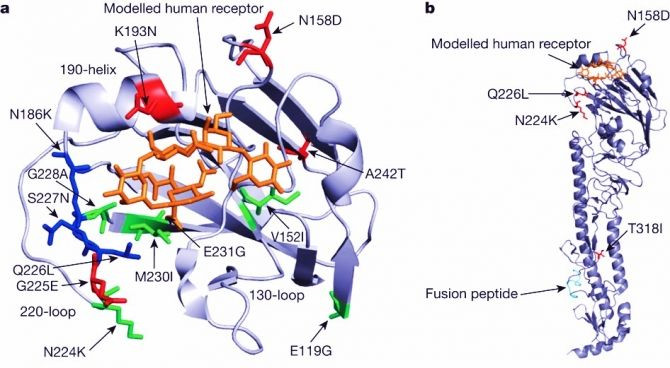Controversial Mutant Bird Flu Paper Published after Months of Intense Debate

After four months of debate on whether the publication of the controversial research on a mutant bird flu strain that can spread easily between mammals should be allowed, the journal Nature has finally published the first of two studies on the experimental deadly influenza virus that U.S. biosecurity experts had feared could be used as a bioterrorism weapon.
The publication of the research by Yoshihiro Kawaoka of the University of Wisconsin, Madison, on Wednesday comes after months of fierce debate between advocates for science to be free of censorship and those who felt the need to protect the public from a potentially devastating influenza epidemic.
The controversy started in December when two teams of researchers in the United States and the Netherlands said that they had created a mutant form of the H5N1 avian virus.
Researchers explained that the goal of their studies were to understand how the H5N1 avian virus, which is highly contagious among birds but is not easily transmitted to mammals, could mutate to spread rapidly between people, and could provide scientists and health officials more information in case of a flu epidemic.
However the National Science Advisory Board for Biosecurity, an expert panel that advises the U.S. government, called for Nature and Science, two journals that planned on publishing the flu research, to delete certain parts of the original studies before it should be published.
The board feared full disclosure of the two papers could help bioterrorists make a highly contagious form of the virus that no one is immune against, possibly triggering potential danger of “unusually high magnitude,” to the public.
Many scientists criticized the board’s recommendation and said that it was an attempt for government to censor scientific discourse and stifle advancement.
Since then, both Nature and Science had put publication of the papers on hold while experts around the world reach a consensus on how to proceed with the publication of the studies.
The British journal Nature finally published one of the studies online on Wednesday, and the journal said that “the essential scientific elements (in the original text) were unchanged” after the British journal had received and reviewed "several independent pieces of biosecurity advice".
The published study revealed that four mutations in a key hemagglutinin gene of the mutant strain of the avian flu allowed the bird flu to adapt to mammals.
Kawaoka and his team and developed the mutant strain by combining the hemagglutinin gene from the H5N1 virus to the pandemic strain of the 2009 H1N1 swine flu virus, and after adding four other gene mutations and some spontaneous alterations that occurred in the ferrets, the virus started to successfully spread among ferrets, which are the best model for predicting whether the virus is capable to spread among humans.
However a modified virus, which combines the modified H5N1 gene and seven genes from the human H1N1 pandemic, was not lethal to ferrets used in the experiment, and researchers are still unsure whether the H5N1 viruses that already exist in nature that contain one of the mutations they found, will soon evolve to be easily transmitted among humans.
"One of the mutations we identified is already circulating in viruses in the Middle East and Asia, so there is concern about these viruses in nature acquiring more mutations and becoming transmissible in mammals," Kawaoka told the Guardian. "If surveillance teams know which mutations are important … they can be alert for the emergence of viruses with pandemic potential and inform authorities to take appropriate precautions."
Infected ferrets could easily infect other animals through respiratory droplets, which proves that the new virus was airborne and could spread through coughs and sneezes, the hybrid virus did not kill any of the ferrets that contracted it.
The mutant strain was spread slower than the 2009 pandemic H1N1 strain, cause less harm in the lungs and was susceptible to both the front-line drug Tamiflu and a prototype vaccine against H5N1.
Nature magazine had showed journalists a report from "a bio-defence agency outside the US" which it did not name, that indicated that the benefits of publication outweighed the risks, according to AFP.
"This information could be used by an aggressor and shows one of the building blocks for the development of a potential BW [biowarfare] weapon," the report said. "[Such skill] is a demanding capability, probably beyond the capacity of the majority of those groupings of concern," it said.
"On the other hand, not publishing this information would slow, or even block, the development of a vaccine against a virus that still has the potential to mutate naturally to a pandemic form, which could cause huge numbers of fatalities worldwide,” according to the report.
Nature said that while it was “desirable” to have a forum like the NSABB, it has been made clear that the “committee's original deliberations were too limited, especially given the enormous implications for flu research of a recommendation against publication.”
"There are justified concerns among the research community about the NSABB's processes, and these processes should be reviewed," the journal said.
The other study, which would be published by the U.S. journal Science, is by researcher Ron Fouchier of the Erasmus Medical Centre in Rotterdam.
"We had originally hoped, as a public service, to be able to publish Dr. Fouchier's paper simultaneously with the similar research by Dr. Kawaoka. But appropriate review and editing of the manuscript is the primary goal," spokeswoman Ginger Pinholster for the American Association for the Advancement of Science (AAAS), which publishes Science, said, according to AFP.



























